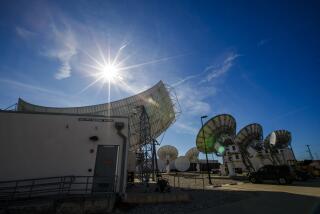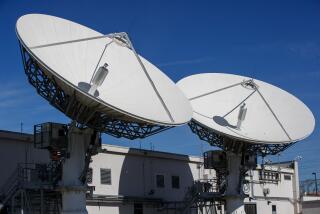Son of Sputnik
- Share via
Maybe it’s the selection of movie channels or the increased access to sports programming and international broadcasting. It could be the couple hundred all-around viewing options or simply the high audio and video quality.
Whatever the reason, satellite dishes for TV viewing are more in demand than ever. And with competition fierce among the leading providers, subscription and installation prices have dropped--to about half of what they were just a few years ago.
Not surprisingly, it’s a good time to purchase a satellite system, although there is one caveat: What may be top-of-the-line today could be bordering on obsolescence in the very near future.
“The real calling card is that video and audio quality [on satellite systems] is typically higher than it is on cable,” said Johnny Fare, audio manager and buyer at Wilshire TV & Stereo in Thousand Oaks. “And this is even as technology advances, with Dolby sound and now high definition.”
The thought of satellites hovering over Texas bouncing signals to 18-inch receivers at millions of homes in the United States seems as 21st century as it gets--something the Jetsons only dreamed about. But the bottom line is not as complicated as the technology involved.
It comes down to a choice, basically, between two satellite systems--DirectTV and the Dish Network (operated by EchoStar).
A third primary provider, Primestar, is being purchased by DirectTV. And another company, Unity Motion, has just entered the scene offering, initially, three channels of high definition satellite broadcasts. This is a feature DirectTV and the Dish Network also plan to incorporate into their systems within the next six months.
Satellite dishes are available at electronics stores and audio-video retailers as well as general retail stores like Kmart and Montgomery Ward. The Dish Network is available at satellite and some electronics dealers or direct from the factory by calling (800) 333-DISH.
Expect to pay a minimum of $100 for a basic setup for DirectTV and $149 for the Dish Network, with prices going up as features are added. The cost is more for feature that allows two sets to be hooked up to operate independently on the same system.
Subscription charges are $20 to $50 monthly for basic service, but discounts and rebates are common as the providers battle for customers. The Dish Network, for example, is offering to rebate the cost of the basic equipment if subscribers sign up for a certain number of months at a certain price.
Stores charge additional fees for installment, or customers may purchase a do-it-yourself installation kit.
“The basic system is what the name implies, for $100 on up,” said Hank O’neill, a salesman at DBS Satellite Television in Ventura. “From there you can go into receivers that have Dolby Digital available and built-in recorders, for as high as $700 or $800. The average deluxe system today, with the discounts, you can get for $200 or $300. It’s gotten that competitive. When these things started out you were looking at $1,000 just to get something put in.”
Selecting between DirectTV and the Dish Network comes down to viewing preferences. Both offer a lot of channels--more than 200 for DirectTV and close to 200 for the Dish Network. But each has its own special packages that cost additional subscription fees.
DirectTV has a significant edge in professional sportscasts and offers many more pay-per-view movie options. The Dish Network offers an extensive foreign language selection and provides local network coverage out of select cities, including Los Angeles.
Providing access to local networks is a controversial issue that has been contested in court and for now, at least, DirectTV cannot offer the service. DirectTV subscribers need cable or a roof-top antenna to receive local network broadcasts.
There is also a difference in the equipment used for the two satellite systems. The Dish Network has its own brand of equipment, while equipment for DirectTV is supplied by electronics manufacturers such as Sony, RCA and Toshiba.
“They’re pretty much the same picture, same sound, it’s more the features that [differentiate] them,” said Keith Bauereis, the video sales coordinator at Circuit City in Newbury Park.
“Sony is one of the smallest in physical size, if you have a space problem,” he said. “The programming guides are different--RCA has a pull-up menu, with Sony you can pull up the menu and see through to what is being played at the same time.”
But Fare, for one, thinks many features may be less important, as picture quality improves.
“There is always a conflict between quality and quantity--do you want more channels or better quality?” Fare said. “I think that many people are just overwhelmed with the number of channels available. This may be heresy, but how much TV can you watch? . . . When people see the quality of high definition television there will be a demand for quality rather than quantity.”
More to Read
The biggest entertainment stories
Get our big stories about Hollywood, film, television, music, arts, culture and more right in your inbox as soon as they publish.
You may occasionally receive promotional content from the Los Angeles Times.










